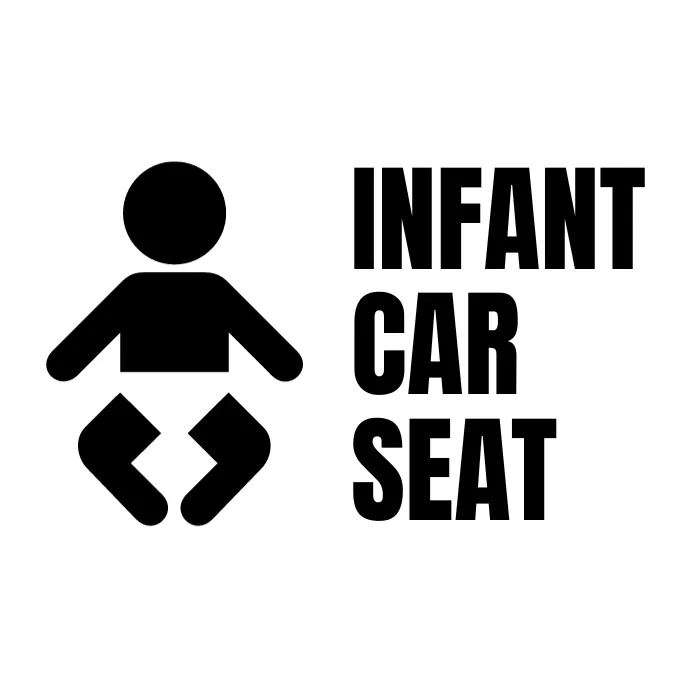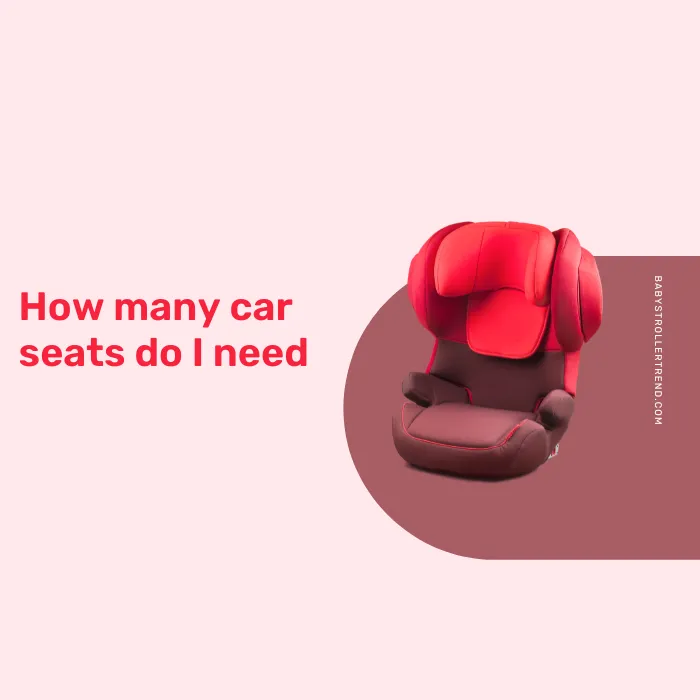How many car seats do I need? Figuring out how many car seats you require for your family can be confusing. Do you need just one to cover all ages and stages? Or will you need to purchase multiple seats as your children grow?
As a mom of three kids, I’ve been through my fair share of car seats, including bucket seats, high seat backs, and seats and boosters for various ages and needs.
And let me tell you, the number of seats needed definitely depends on your individual family size and situation.
In this article, I’ll walk you through determining exactly how many car seats you need as your family expands, taking into account factors like the car seat manufacturers’ recommendations, installing your car seats, and whether you should consider a second-hand car seat.
Let’s dive in and make sure you have the right car seats to make your family’s journeys safe and comfortable!
Car Seat Basics: Infant car seat
First, a quick car seat primer. Car seats are designed to safely transport children in vehicles based on their:
- Height
- Weight
- Developmental stage
There are four main types of car seats:
- Infant seats: Rear-facing for newborns to infants
- Convertible seats: Rear- and forward-facing for infants to older kids
- Booster seats: Forward-facing and boosting for older children
- All-in-one seats: Span all stages from infant to booster
Children start in rear-facing infant seats until at least 2 years old before graduating through the stages. Knowing the types of seats helps determine how many you need.
How many car seats do I need? Calculate By Number of Children
The number of car seats required is first based on the number of children you have. Here are some guidelines:
1 child: You’ll need at least 2 seats – one rear-facing infant seat and one forward-facing convertible or all-in-one seat.
2 children: Plan for at least 3 seats – a rear-facing and forward-facing seat for each child.
3 children: Calculate at least 4 seats – one for each child, including an infant seat for the youngest.
4+ children: Estimate at least 1 seat per child, plus an infant seat for the baby.
Of course if your children are close in age, they may overlap stages and require fewer total seats. But for planning purposes, estimate 1 seat per child as a baseline number.
Consider Seat Stages
The number of required seats also depends on the stages your children are in.
Infants start in rear-facing seats until at least age 2. So plan for one infant seat for each baby and toddler. It’s essential to ride in a rear-facing seat to ensure their safety in the car.
Once a child maxes out an infant seat’s height and weight limits, they’ll transition to a convertible seat used rear-facing at first. Soon after, they’ll flip the convertible seat to forward-facing mode.
Kids around 4 years old who outgrow the forward-facing limits will graduate to a belt-positioning booster seat. It’s crucial to make sure the car seats are compatible with your vehicle for each stage of your child’s growth.
Older kids in boosters can often share seats. Still, some families prefer having a booster for each child. Consult with a certified child passenger safety technician when shopping for car seats to ensure you choose the right ones for your family.
Considering the stages of seats your children will move through helps estimate your car seat needs. Don’t forget to account for a new infant seat with each new baby to keep them safely in the car.
Read the Labels: Height, Weight, and Age Limits

The labels on car seats contain height, weight, and age limits that dictate when kids should switch seats.
For example:
- Rear-facing infant seats have limits like 30 lbs and 32”.
- Forward-facing seats list limits like 65 lbs and 52″.
- Boosters often list limits like 100 lbs and 57”.
There is no set age when kids will max out their seats. You have to watch their size.
Pay attention to the limits on your existing seats. Know when your child is approaching the maximums so you can purchase the next appropriate car seat that best suits their needs in a timely manner.
Properly tracking each child’s size, weight, and age indicators against their seat limits ensures they transition at the right time.
For instance, some children may require a booster car seat to allow the seat belt to fit properly when they’ve reached the height allowed by their car safety seat. Others might need a car bed to ensure the seat belt properly secures them.
By keeping a close eye on these factors and the limits of your three car seats, you can make informed decisions about when to move your child to the next car seat that best fits their growth and safety requirements.
Factor In Multiple Vehicles
Don’t just count the seats needed for one car. Think about all the vehicles your family uses regularly.
Do you:
- Swap one seat between vehicles? This gets old fast.
- Drive Grandma’s car sometimes? Her seat may not fit your kid.
- Drop-off/pick-up with your spouse? You’ll both need seats.
- Travel between two houses? Car seats at both are ideal.
- Use rideshare services? You’ll need a seat in every Uber/Lyft/Taxi.
The number of seats needed multiplies quickly when considering all the vehicles in your family’s life.
Even occasional drivers like grandparents should have proper seats available for the safety of your children.
Hand-Me-Downs and Reusing Seats
It’s tempting to use hand-me-down seats and reuse seats between kids to save money. This can be smart, with a few caveats:
- Check labels/expiration: Used seats must be in good condition and not expired.
- Match stage needs: Be sure the seat will work for the next child’s height, weight and age.
- Check for recalls: Verify the seat doesn’t have any safety recalls.
- Inspect thoroughly: Look for cracks, wear and tear, frayed straps, etc.
- Store carefully: Seats not in use need proper storage to remain safe and usable.
Reusing seats between children or using from friends/family is great when seats are gently used and meet the next child’s needs. But cutting corners or compromising safety is never okay. Only use seats in excellent condition for the right stage.
Budgeting For Multiple Car Seats
Car seats are a significant baby gear investment. Buying multiple seats adds up quickly.
Good quality seats range from $100 to $400 each. And you may need 4, 5, or more total! However, the cost is a small price to pay for your child’s safety in car crashes.
When choosing a car seat, ensure it’s the right seat for your child’s age, weight, and height.
Whether you opt for a rear-facing infant seat or a rear-facing convertible seat, make sure you consult the seat manual and follow the manufacturer’s instructions closely.
Proper installation is crucial, whether you’re using a seat belt to install or lower anchors. Keep in mind that some seats can be used in more than one car, providing flexibility and convenience for parents on the go.
Investing in the right seat is an investment in your child’s safety during every car ride.
Here are tips for affording all the seats your family requires:
- Research sales and snag deals when possible. Retailers often discount certain seats or models.
- Consider more budget-friendly brands that meet safety standards but cost less.
- Ask relatives to gift seats for birthdays and holidays. Car seats top many baby registries.
- Check local consignment sales for like-new used seats if you’re comfortable.
- Spread out purchases instead of buying everything at once if needed.
Having the right seats keeps your children safe. With savvy shopping, budget-friendly options, and some help, you can outfit all your family vehicles properly. Don’t cut corners – your children are priceless.
Car Seat Safety Rules
Amid determining how many seats you need, remember these fundamental safety rules:
- Infants must remain rear-facing until at least age 2.
- Keep children rear-facing as long as possible before forward-facing.
- Children should remain in booster seats until they can pass the seat belt test.
- Only use seats that meet safety standards and install them correctly.
- Register your seats to be notified of any recalls.
- Discard seats that are expired or have been in accidents.
There are no shortcuts when it comes to car seat safety. While budget-friendly options exist, every seat must properly fit your child and protect them.
Frequently Asked Questions (FAQs)
How do I figure out the number of car seats needed for my family?
The number depends on factors like how many kids you have, their ages/stages, height/weight limits, vehicles used regularly, and properly reusing seats.
If I only have 1 child, how many seats will I need?
For 1 child, you’ll need at least 2 seats – a rear-facing infant seat and a forward-facing convertible or all-in-one seat.
What’s the baseline number of car seats needed per child?
Estimate needing at least 1 car seat per child as a starting point. But also consider their stages and your vehicles.
How many car seats do I need for an infant?
Infants need a rear-facing only car seat until they reach the height and weight limits, usually around age 2.
At what ages or stages do kids transition to new seats?
The stages are rear-facing infant seat, forward-facing convertible seat, high-back booster seat, then a seat belt.
Should I reuse car seats as my kids grow?
Yes, reuse seats in great condition as long as they fit the next child’s height, weight and age limits. Check for recalls and damage.
Do I need car seats in every vehicle we use?
It’s ideal to have seats in all regular vehicles like both parents’ cars, grandparents’ cars, etc. for safety.
What are some tips for affording all the car seats my family needs?
Look for sales and deals, budget-friendly options, ask for seats as gifts, buy used, and spread out purchases.
What are the basic car seat safety rules to remember?
Kids must remain rear-facing until 2 years old, transition seats based on limits, register seats, and discard expired or damaged seats.
Determine What You Need
As you can see, precisely how many car seats you require depends on several factors:
- Number and ages of children
- The stage each child needs
- Seat limits based on height/weight/age
- Vehicles used regularly
- Reusing seats properly
Take time to assess your unique situation. Identify the seats each child needs now plus those they’ll need in the next few years.
While buying multiple car seats causes sticker shock, remember it’s a short-term expense. Before you know it, those precious babies will be in seat belts and you can pass seats to friends.
Let me know if you have any other car seat number questions! I’m happy to help. Your children’s safety is the top priority.




